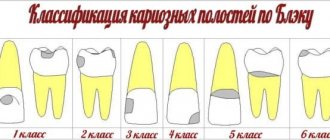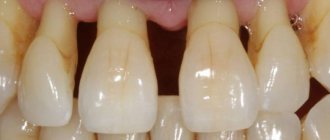Negative or iodine-negative Schiller test
Often, only with the help of a test with Lugol's solution, it is possible to identify areas of pathologically altered epithelium, when upon examination they are visually practically indistinguishable from healthy ones in color and relief, since they do not rise above the surface of the surrounding tissues.
With a negative or iodine-negative Schiller test, the altered epithelium will be stained with Lugol's solution in different shades. The changed areas during the Schiller test have a lighter color, with clear edges - the so-called silent iodine-negative area (usually keratinized epithelium).
Pathologically changed cells are stained with Lugol's solution with different shades, depending on the type of damage and the degree of keratinization (keratinization) of the tissue. In this case, the iodine solution stains only the changed integument (epithelium) with varying intensities of canary yellow color.
Schiller test in gynecology
Exocervicitis and vaginitis with Schiller's test
Exocervicitis is an inflammation of the ectocervix.
Vaginitis or colpitis is an inflammatory process of the vaginal mucosa.
These pathologies are very common.
They are also detected using advanced colposcopy.
Mottling during the Schiller test usually indicates an inflammatory lesion of the mucous membrane of the reproductive organs.
An indicator of inflammation is the appearance of light specks on a brown background.
As a rule, iodine-negative areas have a round shape.
But the Schiller test does not make it possible to determine the cause of inflammation.
This requires additional diagnostic procedures.
PCR or bacteriological culture allows you to identify the pathogen.
Nonspecific vaginitis and exocervicitis are most often caused by Escherichia coli, coccal flora, and corynebacteria.
Specific inflammatory processes are triggered by ureaplasmas, mycoplasmas, trichomonas, and chlamydia.
Schiller test: atrophic colpitis
In addition to bacteria, age-related hormonal changes cause inflammation.
Lack of estrogen leads to atrophic colpitis.
It is detected using the Schiller test.
After staining with 3% Lugol's solution on glycerin, weak and uneven staining of the mucous membrane of the vagina and ectocervix is noted.
Along with other studies, the Schiller test allows for differential diagnosis between infectious and atrophic inflammatory processes.
Their symptoms are often similar.
But if, during bacterial processes, multiple small foci of light color are observed, then with atrophic colpitis, a diffuse change in color is noted.
This is due to the fact that due to estrogen deficiency, there is a decrease in the number of mature epithelial cells containing large amounts of glycogen.
And when its content is low, cells are less stained with iodine.
This information shows the doctor in which direction to conduct further examination.
An accurate diagnosis is established after the appointment of additional diagnostic procedures:
- blood tests for hormones (estrogens deficiency);
- smear for oncocytology (atrophic type of smear);
- according to indications - a smear for infections (excludes STIs).
Cervical erosion with Schiller test
Cervical erosion is mechanical damage to the epithelium.
It looks the same as ectopia or false erosion (pseudo-erosion).
Extended colposcopy, including the Schiller test, helps to carry out differential diagnosis.
In the case of true erosion, it will be negative.
That is, the bottom of the damaged area of the ectocervix mucosa will turn brown in the same way as healthy tissue.
This suggests that no change in the structure of the epithelium occurred.
By origin, erosion can be:
- inflammatory;
- traumatic;
- burn;
- cancerous;
- trophic.
Damage to the epithelium of the vaginal part of the cervix heals on its own after eliminating the influence of the causative factor.
The goal of treatment should be to stimulate reparative processes and normalize the vaginal biocenosis.
Leukoplakia of the cervix with Schiller's test
Leukoplakia is excessive keratinization of the mucous membrane of the cervix.
The pathology is diagnosed quite often - it affects 1.1% of the female population.
Among patients with menstrual irregularities, leukoplakia is found in 12% of cases.
Leukoplakia is a precancerous condition.
Moreover, the risk of malignant degeneration is very high.
Without timely detection and treatment, every third patient will develop cervical cancer over the next 10 years.
The Schiller test helps identify leukoplakia in the ectocervix.
The area of hyperkeratosis is an iodine-negative zone.
It can have different sizes - from a pinpoint plaque to a large formation that occupies the entire vaginal part of the uterus.
Sometimes leukoplakia spreads to the vaginal vaults.
The Schiller test gives the doctor indicative information, but does not confirm the diagnosis.
This requires a targeted biopsy.
The Schiller test is also useful in that it allows you to select an area for collecting clinical material.
Histological examination makes it possible to establish the diagnosis of leukoplakia, identify malignant cells if present, and assess the risk of tumor development.
It allows you to determine the indications for surgical treatment.
Schiller test: cervical dysplasia
Dysplasia is a large group of cervical diseases that are considered precancerous.
Leukoplakia is one of them.
But this is far from the only type of dysplasia.
This concept also includes papillomavirus-associated lesions of the cervix, erythroplakia, and adenomatosis.
Any changes in the epithelium in the ectocervix area can be diagnosed by performing the Schiller test.
This study does not allow differential diagnosis.
However, the detection of areas of multilayer epithelium that are unevenly or weakly stained with Lugol's solution is the basis for a biopsy.
In addition, the procedure makes it possible to determine the optimal location for taking a section of tissue for histological examination.
The Schiller test helps in diagnosing:
- cervical intraepithelial neoplasia (CIN);
- squamous intraepithelial lesions (SIP);
- cervical cancer.
You can perform extended colposcopy with the Schiller test in our clinic.
This study will help to identify inflammatory and precancerous diseases in a timely manner.
If the test result is positive, an experienced gynecologist will prescribe clarifying studies and determine the optimal therapeutic tactics.
To perform the Schiller test, contact the competent gynecologists of our medical center.
Schiller test value
Of great importance in the differential diagnosis of normal and atypical patterns is the color shade and the clarity of the zone boundaries.
The presence of clear boundaries indicates an unfavorable situation. Benign lesions usually have less sharp, blurred contours.
Thus, the test expands diagnostic capabilities and allows:
- preliminary assess the degree of damage, size, depth and number of pathologically changed areas;
- determine patient management tactics;
- evaluate the effectiveness of treatment measures,
- to clarify the features of changes in stratified squamous epithelium under various physiological conditions (pregnancy, menopause, contraception).
Diagnostic methods
The dentist at the dental clinic will tell you in detail about each diagnostic method, but we point out that at the moment the most popular are:
Schiller-Pisarev test
Schiller-Pisarev tests. They determine the presence and amount of glycogen in the gum tissue. If this substance is present in the tissue, then an inflammatory process occurs.
Hygiene assessment
Hygiene level score. The test is carried out on six teeth.
Kulazhenko test
Kulazhenko test (vacuum). A small vacuum tube is placed on the gum and the rate of hematoma formation is monitored. During the inflammatory process it is higher.
Oxygen test
Oxygen test. Determines oxygen saturation of tissues. If the gums are susceptible to hypoxia, it means there is inflammation.
How is the procedure performed?
In order to conduct a Schiller test, a gynecologist must insert a gynecological speculum into the vagina and perform the colposcopy procedure itself, that is, clean the cervix of mucus or discharge and treat its areas with iodine-containing preparations. Most often, doctors resort to using Lugol's solution. After a few minutes, the doctor cleans the sample site of the solution and dries the cervix. After this, he conducts a second examination under a microscope. The procedure takes no more than 5 minutes.
How is the Schiller test performed?
As one of the stages of colposcopy, the Schiller test involves the preliminary introduction of an optical device or mirrors into the lumen of the cervical canal. This is necessary so that the doctor can visually control the area. Next, using a special tampon, the mucous discharge from the cervix is removed, freeing the epithelium for examination. The next preparatory stage is treating the fabric with a solution of acetic acid. Only after all these preliminary procedures have been carried out, the gynecologist applies 10-15 ml to the tissue of the cervical canal. Lugol's solution. The results of the Schiller test are obtained based on inspection of a surface treated with an iodine solution.
The essence of the method is that healthy epithelial cells contain a higher amount of glycogen, which, upon contact with Lugol's solution, becomes intensely stained, giving the tissues a dark brown color. If the tissues are affected by pathology, the amount of glycogen decreases sharply and the staining is less pronounced or does not appear at all. It is the absence of staining of the mucous membrane of the cervical canal that becomes the main sign of the disease.
Indications for the procedure
Colposcopy is one of the generally accepted and recognized diagnostic methods in modern medicine in the field of gynecology. Using this study, the doctor can assess the position of the tissues of the vagina and cervix, as well as determine the presence of benign and malignant neoplasms.
This study should be carried out for women with:
- bloody discharge after sexual intercourse;
- the appearance of itching or uncharacteristic discharge;
- chronic infections;
- infection of the genital organs with the human papillomavirus;
- testing for cancer;
- vulvitis;
- ceresitis;
- colpitis;
- pregnancy planning;
- the presence of any neoplasms.
It is worth noting that in the initial stages of cervical disease there are no specific symptoms, so you cannot check yourself. In this case, it is better to trust the gynecologist.
After the test, the doctor will tell you what the results mean and prescribe the necessary treatment, if necessary.
Doctors advise not to neglect your own women's health and to conduct a Schiller test at least once a year for preventive purposes.
Colposcopy technique
Colposcopy with a smear for oncocytology is the main method for the prevention and diagnosis of precancerous diseases and cancer of the cervix, vagina and external genitalia.
The colposcope is a microscope adapted for this study, which allows one to examine pathological changes in the cervical mucosa under various magnifications.
Modern colposcopes are equipped with devices for receiving and storing photo and video information. This allows the doctor and patient to evaluate the results of treatment over time and consult with other specialists without repeating the study.
A doctor who has an idea of the symptoms of the disease and knows its colposcopic picture can make a preliminary diagnosis with an accuracy of 70-80%. In combination with cytological and histological examination, the material for which is taken during colposcopy, the accuracy of the diagnosis increases to 100%.
Colposcopy is routinely performed in the middle of the menstrual cycle, from 9 to 21 days.
The procedure is performed on a gynecological chair in a gynecologist's office, is short (5-10 minutes) and painless. With the help of a speculum, the walls of the vagina are moved apart, and the cervix becomes accessible for inspection.
First, a general examination is carried out and a smear is taken for atypical (cancerous) cells. At this stage, the doctor evaluates the shape of the cervix, identifies its deformations, ruptures, inflammatory processes and takes a smear for cancer cells for cytological examination.
Then tests are carried out, the purpose of which is to identify hidden lesions of the epithelium of the cervix, vagina and external genitalia, to clarify their size, location and nature. The test consists of examining the mucous membrane after treating it with a 3% solution of acetic acid and Lugol's solution (Schiller test).
Back to contents
Decoding the results of the Schiller test
After treating the mucous membrane with dye, the gynecologist records the result.
- Uniform staining of the tissue in a dark brown color indicates that the woman is healthy, the lining of the cervix is not susceptible to infectious, inflammatory or oncological processes.
- Weak, uneven coloring may indicate the development of atrophic vaginitis, which is often typical for postmenopausal women.
- The formation of light spots on a uniformly colored surface is a sure sign of an inflammatory process in the cervix.
- The formation of iodine-negative areas (uncolored) indicates the presence of pathology, which is limited to the color line. This could be cervical erosion, tissue leukoplakia, benign neoplasms or an oncological process.
Carrying out an informative Schiller test requires the presence of imaging equipment (colposcope). The woman does not experience discomfort or pain. The test does not require special preparation and can be performed directly during a comprehensive gynecological examination.
Diana Medical Center offers a wide range of gynecological examinations to identify diseases of the female reproductive system.
Make an appointment with a gynecologist by calling +7 (812) 528-88-65, request a call back or fill out the appointment form on the page!
Video colposcopy and colposcopic images
Vinegar test
Healthy cervix after treatment with 3% acetic acid. Cloudy mucus is visible. the surface of the mucous membrane is smooth and transparent.
Schiller test
The same neck after treatment with Lugol's solution. The mucous membrane (stratified squamous epithelium) was evenly stained dark brown.
Symptom "Pupil"
Healthy cervix in the middle of the menstrual cycle. At this time, the cervical canal contains a large amount of mucus, due to which the external pharynx expands and takes on a rounded shape - a symptom of a “pupil”.
Cervical erosion
Cervix with ectopic columnar epithelium before and after treatment with 3% acetic acid and Lugol's solution.
- “Erosion” - ectopia of columnar epithelium
- Test with 3% vinegar
- Test with Lugol. The columnar epithelium was not stained because its cells do not contain glycogen
Cervical cyst
Dilated vessels are visible through the thinned mucous membrane of the cyst wall.









